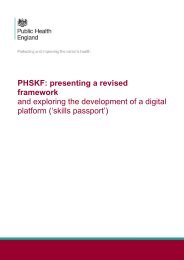Understanding patient flow in hospitals
understanding_patient_flow_in_hospitals_web_0
understanding_patient_flow_in_hospitals_web_0
You also want an ePaper? Increase the reach of your titles
YUMPU automatically turns print PDFs into web optimized ePapers that Google loves.
7 <strong>Understand<strong>in</strong>g</strong> <strong>patient</strong> <strong>flow</strong> <strong>in</strong> <strong>hospitals</strong><br />
2. Sett<strong>in</strong>g an appropriate target for <strong>flow</strong> capacity and establish<strong>in</strong>g plans to<br />
achieve it should be a key objective for Strategic Resilience Groups (to be A&E<br />
Delivery Boards). STP areas should ensure this capacity is built <strong>in</strong>to plann<strong>in</strong>g and<br />
performance processes as a key operational performance target.<br />
3. By provid<strong>in</strong>g a focus on ways of achiev<strong>in</strong>g the four-hour standard, there<br />
should be a greater understand<strong>in</strong>g of delivery risk, lead<strong>in</strong>g to more timely and<br />
effective responses. We identify three ma<strong>in</strong> approaches for achiev<strong>in</strong>g this later.<br />
4. The approach to resolv<strong>in</strong>g complex performance problems should be reviewed<br />
to accelerate learn<strong>in</strong>g and improvement. Better use could be made of the<br />
knowledge and skills available to the NHS to solve complex problems faster,<br />
thereby m<strong>in</strong>imis<strong>in</strong>g the impact of poor service for <strong>patient</strong>s.<br />
Glossary of key terms<br />
Spell – A spell is the full time a <strong>patient</strong> spends <strong>in</strong> hospital, <strong>in</strong>clud<strong>in</strong>g if they are<br />
passed between different wards and consultants.<br />
Bed – When we refer to beds, we mean not just the physical location but the staff<br />
and other resources that go with it to make an NHS hospital bed a safe and effective<br />
place for unwell people receiv<strong>in</strong>g care.<br />
Midnight census – National data on how many beds are occupied is based on<br />
whether they are occupied at midnight. Trusts use the same measure, although some<br />
augment this by count<strong>in</strong>g <strong>patient</strong>s at other times as well. In this report, we argue that<br />
all trusts need to come closer to know<strong>in</strong>g what occupancy is at all times.<br />
Day case – A day case is a <strong>patient</strong> admitted to hospital who is specifically not<br />
expected to need an overnight bed – for example, for a non-urgent operation or test.<br />
Zero-day <strong>patient</strong> – A zero-day <strong>patient</strong> is one who is admitted without the specific<br />
expectation that they will leave with<strong>in</strong> the day, but who ends up not hav<strong>in</strong>g to stay<br />
overnight.



